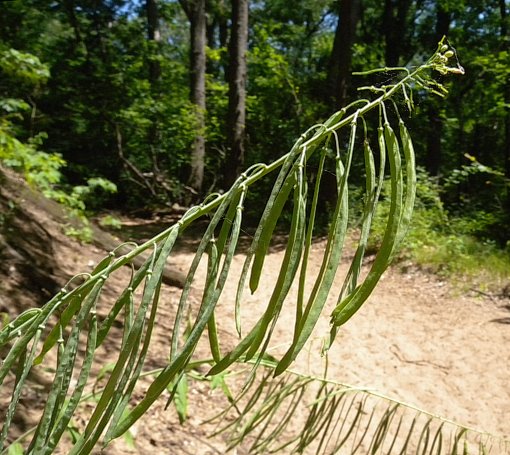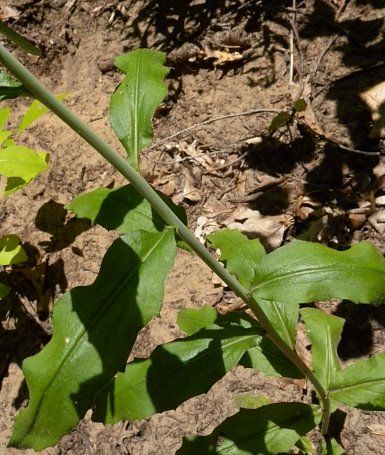
Numerous leaves alternate along the entire length of this stem, becoming slightly smaller as they ascend. These leaves are 2-4" long and ½-1¼" across; they are oblanceolate, elliptic, or lanceolate in shape, smooth or slightly undulate along their margins, and sparsely dentate, tapering gradually to sessile bases. The upper surface of the leaves is medium green and glabrous (or nearly so), while the lower surface is light-medium green and sparsely pubescent. The central stem terminates in a raceme of flowers about 4-16" long. The flowers bloom near the apex of the raceme, while seedpods develop below. Each flower is about ¼" long and a little less across, consisting of 4 white petals, 4 green
Cultivation: Sicklepod prefers partial sun to light shade and mesic to dry conditions. It adapts to many types of soil, including those that are rocky or sandy. During dry periods, the lower leaves tend to wither away.
Range & Habitat: The native Sicklepod is occasional throughout Illinois. Habitats consist of rocky upland woodlands, sandy savannas, wooded slopes, partially shaded cliffs, thinly wooded bluffs, thinly wooded sand dunes, and areas along woodland paths. Sicklepod is usually found in hilly areas that are partially shaded, whether rocky or sandy. Occasional wildfires are probably beneficial in maintaining populations of this species.
Faunal Associations: The nectar and pollen of the flowers attract primarily small bees and flies. These insects cross-pollinate the flowers. Other insects feed destructively on the foliage, flower buds, and other parts of Sicklepod, Boechera spp., and related genera. These species include the flea beetles Phyllotreta conjuncta and Phyllotreta punctulata, and the caterpillars of the following Pierid butterflies: Anthocharis midea (Falcate Orangetip), Euchloe olympia (Olympia Marble), Pieris napi (Mustard White), and Pontia protodice (Checkered White). Very little appears to be known about Sicklepod's interrelationships with vertebrate animals.
Photographic Location: Along a path on a wooded sand dune at the Indiana Dunes State Park in NW Indiana.

Comments: Like most species of its genus, Sicklepod (Boechera canadensis) lacks showy flowers, although its long arching seedpods are distinctive and eye-catching. It is one of several native Boechera spp. and other related genera that can be found in Illinois; they are generally referred to as Rock Cresses. Sicklepod can be distinguished from similar species by its sessile leaves and drooping seedpods. Other similar species within the state have leaves that clasp the stem or their seedpods are more erect. A scientific synonym of Sicklepod is Arabis canadensis.